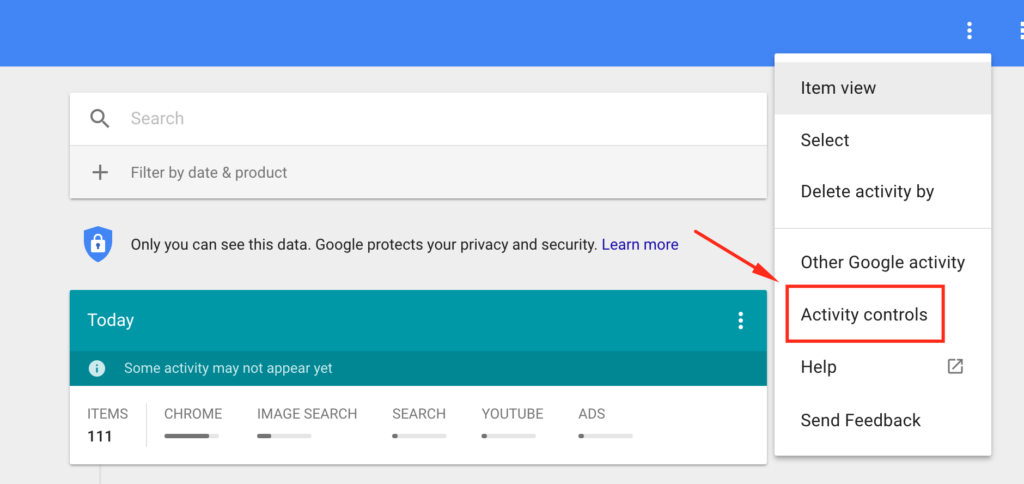

First, you will have to extract the terms to later clean them and thus be able to create a Text Corpus. This is another interesting question that you can answer by viewing the data using the “wordcloud” package.
#Google activity history how to#
How to Analyze and Visualize Your Personal Data Search History - Plot of the relationship between days of the week and time, in which you mostly search What has been the most googled terms in the last two years? For example in my case, I do not think it is a coincidence that the maximum records plotted in 2020 coincide with the red traffic light (closure of all non-essential establishments and remote work from home) established in the country where I live (Mexico). I am almost sure, dear reader, that like me, if you look carefully, a lot had to do with the increase in the number of searches carried out concerning the worst months in which the pandemic covid-19 in your country forced you to stay more at home, and therefore with your devices such as phones, tablets, and computers with internet access. # PLOT SEARCH BY MONTH searchByMonth 2007 & searchedData$year< 2021), ] ggplot(searchByMonth, aes(year, fill=.count.)) + scale_fill_gradient(low = "yellow", high = "red")+ geom_bar(aes(x = month, group = year)) + theme( = element_text(angle=90)) + facet_grid(.~year, scales="free") + labs(x= "Year / Month", y= "Count") + ggtitle("How much your search frequency has changed over time", "Month activity on detail") You can dig a little deeper into the results previously obtained, now visualizing how much the frequency with which you have searched on Google has changed, detailed by months over the years of age that your history has. How to Analyze and Visualize Your Personal Data Search History - Plot of the number of searches per year How much has the frequency of what you search on Google changed over time? (Detailed view by months) There is a very notable increase, mainly in comparison with years before 2014, in which I continued to use the Yahoo search engine mostly, also it seems to me that it must be taken into consideration that access to increasingly faster and faster Internet connections also facilitated the possibility of making more and more queries to Google. That is, 13 years of searches are represented in volume as follows.

In my case, for example, my history goes from 2007 to today, in 2020. # PLOT SEARCHED BY YEAR searchByYear <- ggplot(searchedData, aes(year, fill=.count.)) + scale_fill_gradient(low = "yellow", high = "red")+ geom_bar(width=0.7)+ labs(x= "Year", y= "Count") + ggtitle("How much your search frequency has changed over time", "Search activity by year") searchByYear ggplotly() With the information obtained, you can view the number of searches carried out concerning the years of your history. This could be the first question that you can answer. Screenshot: Console preview of Data Frame created from HTML How much has the frequency of what you search on Google changed over time? # REQUIRED LIBRARIES library(wordcloud) library(lubridate) library(rvest) library(tm) library(tidyverse) # READ DATA fileHTML % html_nodes(xpath = '//div # SCRAPING SEARCH TEXT textSearch % html_nodes(xpath = '//div # SCRAPING SEARCH TYPE searchType % html_nodes(xpath = '//div # CREATE DATA FRAME USING SCRAPED DATA searchedData <- tibble(timestamp = dateSearch, date = as_date(dateSearch), year = year(dateSearch), month = month(dateSearch, label = TRUE), day = weekdays(dateSearch), hour = hour(dateSearch), type = searchType, search = textSearch) searchedData$day <- factor(searchedData$day, levels = c("Sunday", "Monday", "Tuesday", "Wednesday","Thursday", "Friday", "Saturday")) searchedData <- na.omit(searchedData) head(searchedData)Īs a result, you will get a new data frame with 8 variables. First, you must include all the packages that you will use, and establish the reading of your search history, contained in the file “MyActivity.html” that is inside the “Search” folder, contained in the “My Activity” folder. Now you can proceed to work on the information obtained in a new R script. Screenshot: Google Search History HTML File Reading the exported data


 0 kommentar(er)
0 kommentar(er)
